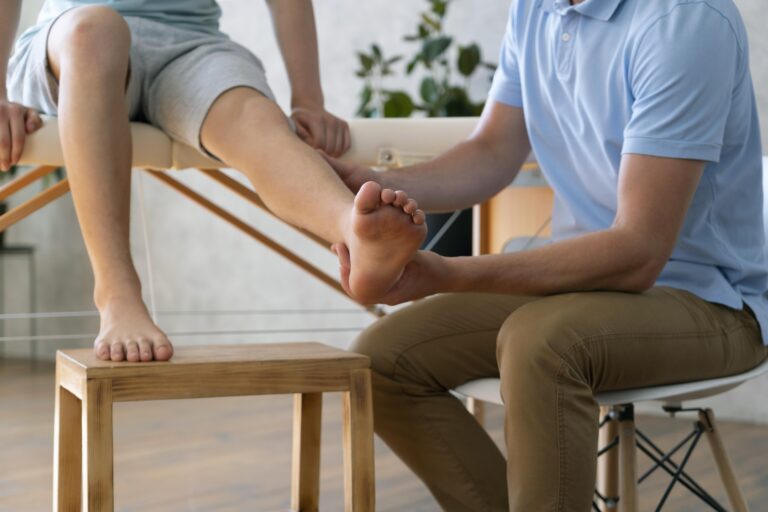Introduction
Plantar fasciitis is one of the most common causes of heel pain, affecting millions worldwide. It occurs when the plantar fascia a thick band of tissue connecting the heel bone to the toes becomes inflamed due to excessive strain or stress. Symptoms include stabbing heel pain, particularly in the morning or after long periods of inactivity, and stiffness that can hinder daily activities.
Managing plantar fasciitis effectively requires addressing its root cause: poor foot support. This is where specialized insoles come into play. Designed to provide arch support, distribute pressure evenly, and absorb shock, insoles help alleviate pain and prevent further damage to the plantar fascia.
This blog aims to guide you through the best insoles for plantar fasciitis in 2024. Whether you’re an athlete, a busy professional, or someone on their feet all day, finding the right insole can significantly enhance your comfort and mobility.
1. What Is Plantar Fasciitis and Why Do Insoles Help?
Understanding Plantar Fasciitis
Plantar fasciitis results from repetitive stress on the plantar fascia, a ligament that supports the foot arch. Common causes include:
- Improper Footwear: Shoes with inadequate arch support or cushioning.
- Overuse: Prolonged standing, running, or walking on hard surfaces.
- Foot Mechanics: Flat feet, high arches, or abnormal gait patterns.
- Excess Weight: Added pressure on the plantar fascia due to obesity or weight gain.
Symptoms often manifest as sharp heel pain, especially during the first steps after waking up or after prolonged rest. If untreated, plantar fasciitis can lead to chronic pain and complications like heel spurs.
How Insoles Help
Insoles are an essential non-invasive solution for managing plantar fasciitis. Here’s how they work:
- Arch Support: Properly designed insoles provide the necessary support for different arch types (flat, medium, or high). This reduces tension on the plantar fascia and prevents overstretching.
- Shock Absorption: Insoles cushion the foot during high-impact activities, such as running or jumping, minimizing stress on the heel and arch.
- Pressure Redistribution: They help distribute body weight evenly across the foot, reducing concentrated pressure on the heel.
- Postural Alignment: Insoles can alleviate strain on the knees, hips, and lower back by correcting foot alignment.
What to Look For in Plantar Fasciitis Insoles
When choosing insoles, consider these critical factors:
- Cushioning: Use materials like memory foam or gel for enhanced comfort and shock absorption.
- Arch Support: Opt for insoles specifically designed for your arch type.
- Fit and Compatibility: Ensure the insoles fit snugly in your shoes without compromising comfort.
- Durability: High-quality materials like carbon fiber or reinforced foam ensure long-lasting support.
- Breathability and Odor Control: Features like perforations or antimicrobial coatings help maintain freshness.
2. Key Features to Consider When Buying Insoles
Focusing on specific features can help you make an informed decision when shopping for insoles to alleviate plantar fasciitis. Here are the critical aspects to evaluate:
1. Arch Support
Proper arch support is crucial for redistributing pressure and relieving strain on the plantar fascia. Insoles designed for low, medium, or high arches help maintain proper foot alignment, reducing stress and preventing further injury.
2. Cushioning
Extra padding, particularly in the heel and forefoot areas, can significantly ease discomfort. Memory foam, gel, or dual-layer insoles are excellent for providing a soft landing, minimizing pain with every step.
3. Shock Absorption
High-impact activities, such as running or jumping, can exacerbate plantar fasciitis. Shock-absorbing materials like EVA foam or polyurethane reduce the force transmitted to the heel, safeguarding the plantar fascia.
4. Material Durability
Durable materials ensure that insoles retain their shape and effectiveness over time. Look for insoles made from high-quality components like carbon fiber, gel-infused foam, or reinforced plastics for long-lasting performance.
5. Fit and Compatibility
The best insoles should fit your shoes perfectly without causing discomfort. Some insoles are designed for specific footwear types (e.g., athletic shoes, casual sneakers, work boots), so choose accordingly. Trim-to-fit options can provide additional flexibility.
By understanding these key features, you can select insoles that cater to your unique needs, ensuring both comfort and relief.
3. Top 10 Best Insoles for Plantar Fasciitis Relief in 2024
1. Superfeet Green Insoles
- Key Features: High-density foam, deep heel cup, and maximum arch support.
- Price Range: $45 (Mid-range)
- Best Suited For: Athletic shoes, hiking boots, and work boots.
- Customer Reviews: Widely praised for durability and pain relief in various activities.
2. Powerstep Pinnacle Maxx
- Key Features: Dual-layer cushioning, firm arch support, and anti-microbial fabric.
- Price Range: $44 (Mid-range)
- Best Suited For: Casual shoes and running sneakers.
- Customer Reviews: Users love its ability to alleviate heel pain during long walks.
3. Dr. Scholl’s Plantar Fasciitis Pain Relief Insoles
- Key Features: Targeted shock absorption and adaptive arch support.
- Price Range: $14 (Budget-friendly)
- Best Suited For: Casual shoes and sneakers.
- Customer Reviews: Affordable and effective, with noticeable pain relief.
4. Walk Hero Comfort and Support Insoles
- Key Features: Arch support, cushioning, and heel cup stabilization.
- Price Range: $15 (Affordable)
- Best Suited For: Athletic and everyday shoes.
- Customer Reviews: High satisfaction for reducing foot fatigue and heel pain.
5. Spenco Polysorb Cross Trainer Insoles
- Key Features: Lightweight design, shock absorption, and energy return.
- Price Range: $19 (Mid-range)
- Best Suited For: Cross-training and sports shoes.
- Customer Reviews: Popular for athletic use, with excellent durability.
6. Sof Sole Plantar Fascia Orthotic Insoles
- Key Features: Gel heel pad, reinforced arch support, and lightweight construction.
- Price Range: $15 (Mid-range)
- Best Suited For: Athletic shoes and work boots.
- Customer Reviews: Effective for heavy-duty activities and extended wear.
7. Tread Labs Ramble Insoles
- Key Features: Customizable arch support and anti-odor properties.
- Price Range: $60 (Premium)
- Best Suited For: All-day use in various footwear.
- Customer Reviews: Known for excellent adjustability and comfort.
8. Vionic Full-Length Orthotic Inserts
- Key Features: Podiatrist-designed support and durable cushioning.
- Price Range: $40 (Mid-range)
- Best Suited For: Everyday wear and formal shoes.
- Customer Reviews: Great for maintaining foot alignment and posture.
9. Physix Gear Sport Full-Length Inserts
- Key Features: Dual-layer cushioning and ergonomic design.
- Price Range: $12 (Mid-range)
- Best Suited For: Sports and casual shoes.
- Customer Reviews: Highly regarded for comfort and affordability.
10. CURRFoot Customizable Insoles
- Key Features: Heat-moldable fit for precise arch support.
- Price Range: $60 (Premium)
- Best Suited For: Tailored use for specific foot shapes.
- Customer Reviews: Praised for its personalized fit and premium feel.
This comprehensive list provides a range of options tailored to varying needs, ensuring relief and comfort for those dealing with plantar fasciitis.
4. Detailed Reviews of the Top 3 Insoles
1. Superfeet Green Insoles
- Pros:
- High arch support for optimal alignment.
- Durable construction for long-term use.
- The odor-control coating keeps feet fresh.
- Cons:
- Can feel rigid initially; may require a break-in period.
- Higher price point compared to generic insoles.
- Testimonial:
- A user with chronic plantar fasciitis reported significant pain reduction after two weeks of use, especially during long work shifts.
2. PowerStep Pinnacle Insoles
- Pros:
- Dual-layer cushioning for added comfort.
- Built-in arch support and heel cradle for stability.
- Compatible with a variety of shoe types.
- Cons:
- Slightly bulky, and may not fit well in narrow shoes.
- Testimonial:
- An athlete shared improved performance and less foot fatigue during high-impact activities.
3. Dr. Scholl’s Plantar Fasciitis Pain Relief Orthotics
- Pros:
- Specifically designed for plantar fasciitis.
- Gel cushioning provides targeted pain relief.
- Affordable and widely available.
- Cons:
- Less durable than premium options.
- Limited size range.
- Testimonial:
- A user praised these insoles for providing immediate relief during a week-long vacation involving extensive walking.
5. How to Choose the Right Insoles for Your Needs
1. Consider Your Activity Type
- Running or Sports:
- Look for insoles with enhanced shock absorption and stability, such as those by Superfeet or PowerStep.
- Standing for Long Hours:
- Choose insoles with thick cushioning and arch support, like the Dr. Scholl’s options.
- Casual Wear:
- Opt for lightweight, slim insoles that fit snugly into everyday shoes.
2. Check for Fit and Comfort
- Ensure the insole fits your shoe properly without crowding the toes.
- Test the arch alignment and cushioning by walking or standing for a few minutes.
- If possible, try insoles with a satisfaction guarantee for added peace of mind.
3. Consult a Podiatrist if Necessary
- If over-the-counter options don’t relieve your symptoms, consider custom orthotics.
- A professional evaluation can help diagnose specific issues like overpronation or high arches, ensuring a tailored solution.
6. Maintenance and Care for Insoles
To maximize the lifespan and effectiveness of your insoles, follow these care tips:
1. Regular Cleaning
- Wash insoles with mild soap and warm water as needed.
- Avoid harsh detergents that could damage the material.
2. Proper Drying
- Air-dry insoles away from direct sunlight or heat sources to prevent warping.
- Do not use a dryer, as excessive heat can compromise durability.
3. Replacement Schedule
- Replace insoles every 6–12 months, depending on usage intensity.
- Monitor for signs of wear, such as flattened cushioning or diminished support.
7. Final Thoughts on the Best Insoles for Plantar Fasciitis
Investing in quality insoles is a proactive step toward managing plantar fasciitis. By prioritizing features like arch support, cushioning, and material durability, you can significantly reduce pain and improve your overall foot health.
No matter your lifestyle or budget, the options outlined here offer a solution for everyone, from professional athletes to everyday walkers. Explore these recommendations and experience the relief and comfort you deserve.
Conclusion
Choosing the right insoles is a critical step in managing plantar fasciitis effectively. Proper insoles not only alleviate pain but also prevent further complications, improving your daily comfort and overall foot health. By prioritizing features like arch support, cushioning, and durability, you ensure a proactive approach to your well-being.
Don’t compromise on your foot health—explore the featured insoles in this blog to find the perfect fit for your lifestyle. Remember, a small investment in the right insoles can make a significant difference in your comfort and mobility.
FAQs (Frequently Asked Questions)
- What is the average lifespan of insoles for plantar fasciitis?
Insoles typically last between 6–12 months, depending on usage frequency and intensity. Signs of wear, such as reduced cushioning or support, indicate it’s time for a replacement. - Can I use these insoles in all types of shoes?
Most insoles are versatile and fit various shoe types, including athletic, casual, and work shoes. However, ensure they match your footwear’s size and design for the best fit. - Are these insoles suitable for runners?
Yes, many of the insoles reviewed here are designed for high-impact activities like running, offering excellent arch support and shock absorption to reduce strain. - How do I know if I need insoles or custom orthotics?
If over-the-counter insoles don’t alleviate your symptoms, or if you have severe or unique foot conditions, consult a podiatrist for custom orthotics tailored to your needs. - Can insoles completely cure plantar fasciitis?
While insoles are highly effective in managing pain and supporting recovery, they don’t cure plantar fasciitis. Combining insoles with proper footwear, stretching, and medical advice leads to the best results.
“Disclaimer: This post contains affiliate links. If you make a purchase through these links, I may earn a small commission at no extra cost to you. Thank you for supporting my blog!”



[…] absorbing insoles are an uncomplicated but effective solution for improving foot comfort, fatigue, and damage protection to the joints from impact in everyday life. Whether running, […]
[…] you have specific foot conditions like flat feet, plantar fasciitis, or chronic pain, consulting a podiatrist for custom orthotics is […]
[…] and cushioning, you may also consider using specialized shoe inserts. Check out our list of the Top 10 Best Insoles for Plantar Fasciitis to find the most effective options for heel pain […]
[…] Recovery from plantar fasciitis is not a quick fix – it’s about being committed to regular, daily maintenance and tuning in to your body. Natural treatments provide an efficient, side-effect-free solution for relief when done with diligence and determination. […]